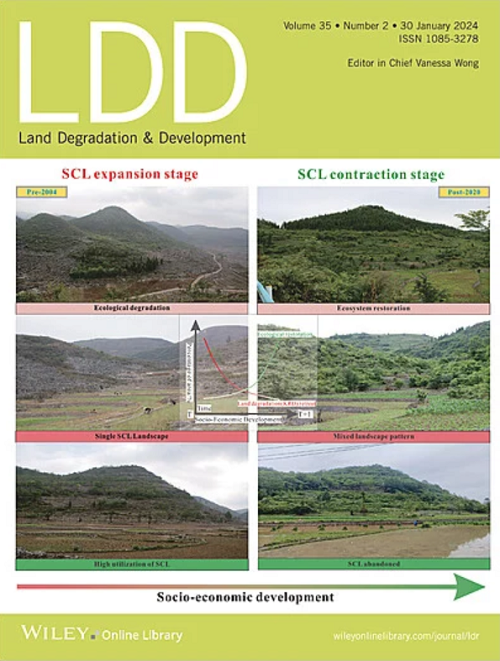In Situ Impact of Waste Polyethylene (PE) Films on Soil Quality and Plant Growth in Agricultural Soil
IF 3.6
2区 农林科学
Q2 ENVIRONMENTAL SCIENCES
引用次数: 0
Abstract
Plastic films have accumulated in soil ecosystems over decades of agricultural activities. These films potentially disrupt the soil structure, hinder nutrient cycling, and deteriorate soil quality. However, there is still a substantial knowledge gap in understanding how real-world waste polyethylene films (WPEFs), with varied shapes and sizes, influence soil quality and plant performance in the fields. This study investigated the effects of WPEFs on soil quality, crop growth, and changes in plastic characteristics. In situ soil incubation was conducted for 4 months under natural field conditions, and lettuce (Lactuca sativa) was cultivated during the period. Soils with 0%–2% of WPEFs were analyzed for physicochemical and biological properties, and lettuces from each soil condition were analyzed for growth indicators after harvest. WPEFs were examined for physicochemical changes using FTIR and SEM. After the incubation, the WPEF 2.0 treatment reduced soil bulk density significantly, from 1.03 to 0.77 g/cm3, and decreased microaggregates (< 500 μm) from 22.2% to 17.2%. Meanwhile, the urease activity increased by up to 208.5% at WPEF 0.5. Although the major chemical properties remained relatively stable, lettuce growth was suppressed considerably. At WPEF 2.0, shoot height decreased by 45%, whereas total fresh and dry biomass declined by 58% and 46%, respectively. The findings suggest that the reduction in plant growth performance is driven by WPEF-induced changes in soil physical properties, particularly reduced bulk density and disrupted aggregate stability. The combined effects of soil structure and enzymatic imbalances might have contributed to the observed adverse effects on plant growth.废弃聚乙烯(PE)薄膜对农业土壤土壤质量和植物生长的原位影响
塑料薄膜在几十年的农业活动中积累在土壤生态系统中。这些薄膜可能会破坏土壤结构,阻碍养分循环,并使土壤质量恶化。然而,在了解具有不同形状和大小的真实世界的废弃聚乙烯薄膜(wpef)如何影响田间土壤质量和植物性能方面仍然存在很大的知识差距。研究了WPEFs对土壤质量、作物生长和塑性特性变化的影响。在自然田间条件下进行4个月的原位土壤培养,期间种植莴苣(Lactuca sativa)。对wpef含量为0% ~ 2%的土壤进行了理化生物学特性分析,并对不同土壤条件下生菜收获后的生长指标进行了分析。利用FTIR和SEM检测了WPEFs的理化变化。培养后,WPEF 2.0处理显著降低了土壤容重,从1.03 g/cm3降至0.77 g/cm3,微团聚体(< 500 μm)从22.2%降至17.2%。WPEF为0.5时,脲酶活性提高了208.5%。虽然主要化学性质保持相对稳定,但生菜的生长受到了很大的抑制。wpef2.0时,地上部高度下降了45%,总鲜生物量和总干生物量分别下降了58%和46%。研究结果表明,wpef引起的土壤物理性质的变化,特别是体积密度的降低和团聚体稳定性的破坏,驱动了植物生长性能的降低。土壤结构和酶失衡的综合作用可能导致了所观察到的对植物生长的不利影响。
本文章由计算机程序翻译,如有差异,请以英文原文为准。
求助全文
约1分钟内获得全文
求助全文
来源期刊

Land Degradation & Development
农林科学-环境科学
CiteScore
7.70
自引率
8.50%
发文量
379
审稿时长
5.5 months
期刊介绍:
Land Degradation & Development is an international journal which seeks to promote rational study of the recognition, monitoring, control and rehabilitation of degradation in terrestrial environments. The journal focuses on:
- what land degradation is;
- what causes land degradation;
- the impacts of land degradation
- the scale of land degradation;
- the history, current status or future trends of land degradation;
- avoidance, mitigation and control of land degradation;
- remedial actions to rehabilitate or restore degraded land;
- sustainable land management.
 求助内容:
求助内容: 应助结果提醒方式:
应助结果提醒方式:


